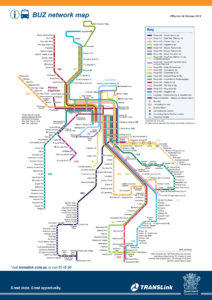
Like other cities in developed countries, Brisbane experienced a rapid decline in public transportation usage in the post war period. Despite an extensive rail network, the proportion of public transport trips in the city declined from roughly 40 percent in the 1960’s to less than 7 percent by 2000. According to the Lord Mayor, the introduction of the busway system arrested the decline of public transport usage in the city. In 2002, 77% of trips in Brisbane were by car, 16% by walking and cycling, and 7% by public transport. As the busway network expands, the proportion of public transport trips is beginning to increase.
The TOD around the Brisbane busway network can be characterized into three general types. First, because the busways are relatively new, they are being used to serve existing structures and communities that previously exhibited many TOD characteristics, but lacked a dedicated transit connection. This is apparent at a number of stations, such as the Cultural Centre, Upper Mt. Gravatt, and the Queensland University, St. Lucia campus stations. Second, the busways are serving as a catalyst for new, green field development near stations. Finally, the busways are catalyzing urban infill.
To date, much of the transit-oriented development that has occurred has been market driven, and the government has done little to influence this development. One notable exception is the Boggo Road Urban Village, a mixed-use redevelopment project managed by the Department of Public Works. However, the government is now beginning to look at incentives that can be created to help target TOD investment. Land use planning in Southeast Queensland is under the authority of the Queensland State Government, which should allow for a more comprehensive approach. Pursuant to the Integrated Planning Act of 1997, local governments are required to prepare Local Growth Management Strategies to implement the regional plan. These local strategies are now required to identify opportunities for TOD. The current regional plan, “Connecting SEQ 2031” emphasizes the importance of transit-oriented development in support of the region’s transportation, economic and environmental goals.